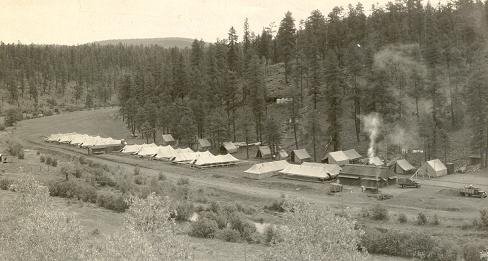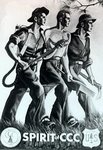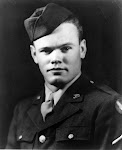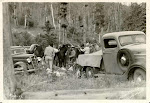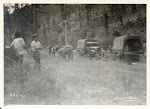It surely was a time of longing, and a time of waiting, and a time of want. Then again, if the heart knows what the heart wants, the heart surely cannot know what it has never had, nor ever known of. Some children growing up during the Great Depression may have wanted for nothing because they never had anything in the first place. In the end, the only thing they knew they were lacking was the close, loving comfort of a parent who'd been sent away in pursuit of work.
As the door closes on this year, and a new year dawns, I’d like to finish off my 2010 posts with a simple remembrance of a little girl, in a tiny Colorado town in the 1930s. Some seventy years after the fact, she would recall laying at the foot of the bed in an upstairs bedroom, watching through the window, down a darkened street, waiting for a car to turn down the street because she knew it would be her beloved daddy, home from  his job as a foreman in a faraway CCC camp. Their town was small and very little traffic moved through the streets so she could always be certain it was daddy when the car made that final turn down their street – it couldn’t be anyone else, but her daddy.
his job as a foreman in a faraway CCC camp. Their town was small and very little traffic moved through the streets so she could always be certain it was daddy when the car made that final turn down their street – it couldn’t be anyone else, but her daddy.
While he was away at camp, her daddy wrote a series of stories about The Whoppenhollar kids, who were modeled and named after his very own five children: Billy, Frank, the twins Jean and John and little Glen. He’d mail those stories home from CCC camps in places like Norwood, Delta, Gardner and San Isabel, Colorado.
One lucky Thanksgiving, her daddy was assigned to the CCC camp just a few miles down the road and the family was invited to attend the holiday dinner in camp. She would always remember the bounty that was spread across that camp table and recall that she’d never seen so m uch food in her young life. She would also remember visiting daddy in distant camps and she would recall the kindness of the camp officers. Thirty years later it would be remembered that through it all, daddy always managed to be home for the holidays.
uch food in her young life. She would also remember visiting daddy in distant camps and she would recall the kindness of the camp officers. Thirty years later it would be remembered that through it all, daddy always managed to be home for the holidays.
It isn’t a stretch to say that the creation of the CCC in 1933 saved the Rutherford family. Bill Rutherford landed a job as a camp foreman during that first year and he worked for the CCC and for FERA until 1942. His work far from home meant food on the table, even if it did come at the expense of time spent close to his wife and children.
Now, as the calendar turns over to 2011, I look back with sadness at the fact that three of the five Whoppenhollar kids – John, Jean and Frank - have traveled on ahead, gone from this life and now joined with their mamma and daddy.
Sure, the heart knows what the heart wants and a small child always knows what they want most of all, which is for their parents to be close at hand.
Friday, December 31, 2010
Missing the Important Things During the Great Depression
Posted by
Michael
at
3:41 PM
0
comments
![]()
Labels: The Whoopenhollar Kids
Wednesday, November 17, 2010
Spotlight Site: The CCC in Kansas

I particularly like the posting about the artwork of Joseph A. Johnson and the article’s unanswered question, “what happened to Joseph Johnson?”
So much of the CCC story has been written and documented through the work of camps in the eastern and western U.S. with little notice given to the valuable work of the enrollees in America’s heartland. The Civilian Conservation Corps in Kansas includes a useful listing of CCC companies assigned to Kansas. Not surprisingly, the bulk of the focus seems to have been on soil erosion work.
Finally, the posting entitled “The Future of the CCC” is especially noteworthy because in it, an enrollee writes that perhaps one day, as old men, former enrollees will visit the public square and find erected there a statue of a CCC boy in honor of their accomplishments. And isn’t that exactly how it’s transpired? Amazing.
Posted by
Michael
at
5:42 PM
2
comments
![]()
Labels: Spotlight Site
Wednesday, October 6, 2010
Mysteries and Conundrums, Indeed: CCC Camp Remnants in Your Neighborhood?
 So often, the locations of former CCC camps are lost to history or perhaps known only to a few local residents and historians. Sadly, when the last of the locals pass away, they may likely take with them the last bit of knowledge regarding where the CCC camp stood in their neighborhood. In the future, it will fall to local historians to document this information and the better the documentation, the better the preservation.
So often, the locations of former CCC camps are lost to history or perhaps known only to a few local residents and historians. Sadly, when the last of the locals pass away, they may likely take with them the last bit of knowledge regarding where the CCC camp stood in their neighborhood. In the future, it will fall to local historians to document this information and the better the documentation, the better the preservation.While doing a Google blog search for posts related to the Civilian Conservation Corps, I came across the blog Mysteries and Conundrums where there was posted an article entitled A Camp in the Wilderness: CCC Camp MP-4. Please read it; it’s as good a bit of CCC sleuthing as you’re likely to find anywhere on the net. The author provides not only an excellent bit of geo-referencing that includes a comparison of aerial photos from the 1930s and today, but also some fascinating background on the camp and its baseball diamond.
There is a similarly situated CCC camp in the Phoenix area (actually the site of two camps) and, unless you’re a CCC historian, a park ranger or perhaps an avid hiker, you’d likely miss the signs that tell you that a community of up to 400 young workers once lived in the area. The original flagpole base – likely constructed by enrollees from Texas – is still in place, but hidden by native vegetation and likely protected from vandalism as a result.

Which brings us to the potential downside of knowing about and revealing the locations of these old CCC camp sites. How much information is too much information? Fortunately, what little remains of Camp MP-4 is likely protected simply because it rests within the Fredricksburg and Spotsylvania County Battlfields Memorial, and likewise, the Phoenix CCC camp is inside a City of Phoenix Park, but what of the hundreds of CCC camps spread throughout the forests and fields of the United States. Fact is, most will continue to decay in silent anonymity, prey to the odd vandal or treasure hunter digging for artifacts, but mostly giving in to the unstoppable march of time and the ravages of mother nature.
All of which, leads me to another interesting topic: the work of the CCC at Civil War battlefield sites. Perhaps a post for next time.
Meantime, some snapshots of CCC camp remnants that I’ve visited….
 Two stone pillars are almost all that remain of the two CCC camps that once operated at Phoenix South Mountain Park, but if you look closely when you're there, you might find the old flagpole stand, too!
Two stone pillars are almost all that remain of the two CCC camps that once operated at Phoenix South Mountain Park, but if you look closely when you're there, you might find the old flagpole stand, too!
 This is the floor of the old latrine and shower building at the former site of the Walnut Creek CCC camp, also near Prescott, Arizona.
This is the floor of the old latrine and shower building at the former site of the Walnut Creek CCC camp, also near Prescott, Arizona. There are a number of remains at the site of the Schultz Pass CCC camp outside Flagstaff, Arizona. Look carefully and you'll see porcelain insulators and wires strung in the trees....
There are a number of remains at the site of the Schultz Pass CCC camp outside Flagstaff, Arizona. Look carefully and you'll see porcelain insulators and wires strung in the trees.... ...and the concrete floors of a number of buildings including what was probably the mess hall and the officer's quarters.
...and the concrete floors of a number of buildings including what was probably the mess hall and the officer's quarters.
But perhaps the neatest CCC camp remnant in Arizona is this "monument" built by CCC enrollees at the Indian Gardens camp near Payson, Arizona....
 It's easily accessible, without so much as a five step walk off a major road, but it's only there for those who truly want to see it. If you whiz by at 50 miles per hour, you'll miss it.
It's easily accessible, without so much as a five step walk off a major road, but it's only there for those who truly want to see it. If you whiz by at 50 miles per hour, you'll miss it.
Posted by
Michael
at
6:23 PM
1 comments
![]()
Labels: Arizona, Civil War Battlefields, Kentucky, South Dakota, South Mountain Park
Wednesday, September 15, 2010
Regimentation. Standardization. Professionalism.
The first rules of sturdy workmanship: work from a good set of plans and have knowledgeable, dependable foremen.
While every CCC enrollee’s story is unique, there is a commonality of experience that runs though the entire program and listening to the stories or reading the personal accounts of former enrollees, one is stuck by common themes that run through the narrative of the Civilian Conservation Corps.
Well, I’ve happened upon a set of photos that may help confirm the universality of the whole CCC experience, while at the same time perhaps speaking to the regimentation that was required to successfully shepherd hundreds of thousands of young men through a national work program, while producing construction improvements of lasting merit.
Flash forward a few years to a hike I took with a fellow CCC historian and advocate in the area around Prescott, Arizona. While walking the grounds of the former CCC camp at Walnut Creek, heads down, strolling through knee-and waist high vegetation, we studied the remains of what once was a shower and latrine building and assorted other structures. But one particular camp remnant spoke to me more strongly than the others that day and it only took a second or two for me to realize I’d seen this sort of construction before.
This pole configuration, evidently set for stringing telephone or electrical wire between buildings in the camp, was nearly an exact twin to the pole installation in the picture from Grand Canyon. I snapped a couple of shots of what otherwise would have been a meaningless, nondescript wooden pole, knowing that somehow there was probably a lesson there somewhere.
Posted by
Michael
at
6:45 PM
2
comments
![]()
Labels: Arizona, Editorial, Grand Canyon, National Park Service, U.S. Forest Service
Tuesday, April 27, 2010
Spotlight Site: Texas Parks & Wildlife Department's "The Look of Nature"
 Our second Spotlight Site is entitled The Look of Nature: Designing Texas State Parks During the Great Depression. The site is operated by the Texas Parks and Wildlife Department and it’s an absolutely outstanding resource for learning about the work of the CCC in 29 Texas parks.
Our second Spotlight Site is entitled The Look of Nature: Designing Texas State Parks During the Great Depression. The site is operated by the Texas Parks and Wildlife Department and it’s an absolutely outstanding resource for learning about the work of the CCC in 29 Texas parks.
Visitors to the site can browse through an interactive Archive of CCC related images, view specific Park Profiles and work through an Interactive Program. There are even video clips and oral histories available at the site.
Texas in particular seems to have a special understanding of the importance of the CCC and its history, which at times seems a bit ironic given that many Texas enrollees were actually shipped out of state to perform CCC work in other states such as Colorado and Arizona. Regardless of how many may have been shipped to other states to work, the enrollees who labored on in Texas made an indelible imprint on the history of the state and their important work is nicely commemorated on this Texas Parks and Wildlife Department Site. Be sure to visit and save it as a favorite.
Posted by
Michael
at
8:07 PM
2
comments
![]()
Labels: Spotlight Site
Monday, April 19, 2010
Revisionist History: Leave the CCC Out of It
Would you tell these guys the CCC was a failure?
It is refreshing to see that the authors of the latest revisionist editorial to come out against the New Deal have wisely chosen to leave out any mention of the most popular and arguably the most successful New Deal program, the CCC.
Burton and Anita Folsom, who both hail from Hillsdale College, wrote earlier this month (ironically, on the anniversary of FDR’s death) that the New Deal did nothing to end the Great Depression. The editorial appeared in the Wall Street Journal and you can read it Here.
Referring to the many “alphabet agencies” created during the New Deal, Folsom and Folsom state that “…the WPA, AAA, NRA and even the TVA (Tennessee Valley Authority) failed to create sustainable jobs.” (I think someone working for the TVA today would beg to differ but that’s an argument they’ll have to make.) For my part I see it as a sign of progress that nowhere in the Folsom’s editorial is there any reference made to the CCC, the ECW or the Civilian Conservation Corps.
I’ve stated many times over that I am not an economist and I’m really not much of an historian and I don’t pretend to be. I’ve made a study of the CCC but when it comes to the larger impacts of the New Deal, I’ll defer to anyone with a reasonable argument. However when a revisionist historian props up their argument by making spurious claims about the CCC, they’d better have their facts straight. For this reason, I’m inclined to applaud the Folsom’s, at least for their having had the good sense to leave the CCC out of it.
I’m reminded of a revisionist rant that came out about five years ago from a gentleman by the name of Richard Ebeling – also associated with Hillsdale College at the time. Mr. Ebeling penned a piece entitled “When the Supreme Court Stopped Economic Fascism in America,” in which he made the following, stunning claim about the Civilian Conservation Corps:
“Much of the urban youth of America were rounded up and sent off to national forests for regimentation and mock military-style drilling as part of the Civilian Conservation Corps (CCC).
You can read the entire editorial here: Richard Ebeling's Article.
I won’t bother to expound on the many ways in which Mr. Ebeling’s claim is outlandish and stupid – he’s a professor of economics who should probably stick to economics – but I will offer some commentary on why I think the Folsom’s were right to leave the CCC out of their argument.
The CCC was not established to create sustainable jobs. If anything the CCC was geared toward removing single, teenaged men from the workforce in order to open up jobs for older men who were often unemployed heads of households. Furthermore, the CCC was created with the goal of improving the health and well being of its enrollees while providing them a chance to help their families through their own hard work (real self-esteem building, not the phony stuff sociologists spout about today). The money an enrollee sent home every month was plowed back into the economy in the form of rent payments and weekly grocery purchases. The CCC wasn’t a cure all and nobody with a lick of sense will attempt to argue that it was. By the same token, nobody with a lick of sense would reasonably claim the New Deal was a failure because of anything the CCC did, except perhaps with respect to its failure to racially integrate the camps.
I’m pleased that we can still discuss the New Deal on its merits and I’m pleased that supporters and detractors can all have their voices and opinions heard. I’m especially pleased that in the last five years or so, we’ve at least learned where the salient arguments are to be made and that the success or failure of a single New Deal program isn’t sufficient evidence for either side and that perhaps the CCC in its own right has risen above the discussion about whether or not the New Deal brought us out of the Great Depression.
To see an earlier editorial regarding revisionist works by Amity Shlaes (The Forgotten Man) and James Powell (FDR’s Folly) see my post entitled The Folly of Revisionist History.
Posted by
Michael
at
4:28 PM
0
comments
![]()
Labels: Amity Shlaes, Editorial, Jim Powell, Revisionist
Tuesday, April 6, 2010
Semper Patria Mea: A New Look For Camp Commanders
 We now know when the insignia worn by the camp staff was changed. But why?
We now know when the insignia worn by the camp staff was changed. But why?
Larger developments and policies that shaped the program between 1933 and 1942 are widely known or at least vaguely understood but often the little facts behind the implementation of the policy are seemingly lost to history – buried deep in a stack of boxes in the National Archives perhaps.
Folks who’ve made a study of the CCC will have noticed that at some point in the lifespan of the program, the officers who ran the camps switched uniforms and their insignia changed from the familiar insignia of the U.S. military to an insignia created specially for the CCC. Bob Audretsch has located an article that spells out this change in the April 13, 1940 issue of Happy Days.
 Under the headline "Eagle and Latin Phrase for Officers", the article reads:
Under the headline "Eagle and Latin Phrase for Officers", the article reads:Washington, D.C. – CCC camp officials are to get a new corps insignia to replace the regulation one now used on CCC uniform hats. Devised by the war Department on request of Director James J. McEntee, the insignia will resemble the drawing above. Specifications now are being drawn by the Army Quartermaster.
The design, somewhat similar to that of the Army, will be of jewelry bronze, 2 ½ inches high, with raised letters. The Latin quotation at the bottom, “Semper Patria Mea,” means “Always My Country.” It was chosen by Director McEntee. The design was executed by the heraldry office of the War Department.
The reason for the switch lies buried in a bureaucratic maneuver that took place in 1939. The War Department was never 100% on board with participation in the CCC program; they were a reluctant partner at first and eventually grew into a grudging participant, having recognized a number of benefits that could be derived from their participation in the CCC program. Nevertheless the relationship between CCC Director Fechner and the War Department was never a close one and by 1939 the War Department was taking steps to have itself absolved of responsibility for the camps.
A move by Congress in April 1939 only served to push the divorce along. On April 3rd Congress voted to give full disability benefits to Reserve officers assigned to active duty with the CCC; this was an expense the Roosevelt administration could not sanction and in response he decided to replace all Reserve officers assigned to CCC camps with civilians and the changeover was complete by the end of 1939. Nevertheless, the War Department remained in control of the camp administration, but the change in policy explains why the insignia of camp personnel was undergoing the changes that are outlined in the short piece from the April 13, 1940 issue of Happy Days. (I’ve drawn on John Salmond’s book The Civilian Conservation Corps: 1933-1942 for background on the change in policy.)
Who knows what other tidbits one is likely to turn up in poring over the old issues of Happy Days newspaper? Future researchers will certainly owe a dept of thanks to Bob Audretsch for his work in compiling the Arizona index for Happy Days. Perhaps other researchers would consider undertaking a similar indexing project for other states. Imagine if stories for all the states and territories were indexed for Happy Days. What a gold mine that source would become.
Posted by
Michael
at
8:53 PM
0
comments
![]()
Buffalo Crossing Camp, Eastern Arizona
